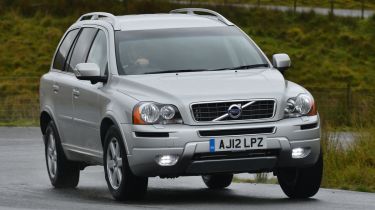Volvo XC90
Big SUV is getting on, but offers premium feel latest Santa Fe is striving to achieve
It’s old and the cabin is really beginning to show its age, but there’s still a certain charm about the XC90. It’s better to drive than either of its rivals here, thanks to its far greater level of grip. ES has miserly kit, although special offer means you could save £7,700 on the price.
If the Santa Fe is going to measure up against a premium SUV, then there’s no better rival for it to face than the Volvo XC90. While the likes of the Land Rover Discovery 4, Mercedes M-Class and BMW X5 head further upmarket, the XC90 has remained unchanged in nearly a decade – so it’s a good barometer of just how far the Hyundai has come.
From the outside, the upright, squared-off Volvo looks a world away from the sharp-suited newcomer. However, the XC90 harks back to the company’s angular models of old, and you couldn’t mistake it for any other car.
The robust interior is equally straight-laced: the XC90’s dash was also designed nearly 10 years ago, and while the simple layout is easy to use, the plastics are hard and shiny. Plus, the small digital display for the stereo looks very dated and is hard to navigate through.
Used - available now
At least the seats are comfortable. They’re covered in cloth trim, but they provide plenty of support, and you can sit in them for hours without feeling any aches or pains. There’s lots of space in the back seats, too.
The rearmost seats are a bit of a fiddle to put into place, because you can’t set them up in one go. The seatbacks flip up, then the bases slide out from under the boot floor. Legroom is even tighter than in the Santa Fe, but you sit high with a good view of the cabin ahead, while large rear windows give passengers a greater sense of space. Those sitting in the rearmost seats also benefit from four cup-holders and a pair of deep bins, so the Volvo is more practical, too.
On the road, it feels like a big car, but it performs respectably. The five-cylinder diesel is only offered with a six-speed auto, and as long as you take things easy, the Volvo is relaxed and comfortable. The long-travel suspension soaks up bumps with ease, but unlike the Santa Fe, the car corners reasonably well. While there’s lots of body roll, there’s more grip than in the Hyundai, and it’s not as unsettled by bumps.
The XC90 is over 200kg heavier than both its rivals here, at 2,129kg, yet was only a couple of tenths behind the automatic Captiva at the track – covering 0-60mph in 10.4 seconds – and never felt underpowered on the road.
But performance isn’t the sticking point; instead, the Volvo falls down when you do the sums. This entry-level ES costs £5,500 more than the Santa Fe, at £35,695, and you’d still need to spend at least £1,000 on extras to get similar kit. And if you want sat-nav, leather or a reversing camera, you have to upgrade to a higher-spec SE Lux or R-Design model.
Still, the XC90 is due to be replaced in the next 12 months, so you should be able to get a discount from dealers. And it’s likely to hold its value better than the Santa Fe, too.
Then again, CO2 emissions of 215g/km mean you’ll pay more in road tax, and Volvo’s three-year warranty looks stingy compared to Hyundai and Chevy’s five-year deals. Do these figures hand the initiative back to the Santa Fe?







